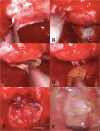Treatment Outcomes of Rathke's Cleft Cysts Managed with Marsupialization
- PMID: 28321372
- PMCID: PMC5357223
- DOI: 10.1055/s-0036-1585088
Treatment Outcomes of Rathke's Cleft Cysts Managed with Marsupialization
Abstract
Objectives Rathke's cleft cysts (RCC) are benign cystic lesions of the sella resulting from incomplete obliteration of Rathke's cleft. Symptomatic lesions often require surgical decompression, which is often amenable to a transnasal, transsphenoidal (TNTS) approach. We report our experience with marsupialization of RCC and describe a novel technique to promote re-epithelization of the cyst cavity. Design Retrospective review. Setting Tertiary academic medical center. Participants Patients who underwent TNTS for RCC between 2007 and 2015. Main Outcome Measures Demographics, lesion characteristics, and reconstruction and treatment outcomes. Results In total, 52 patients were identified. The mean age was 41 ± 18 years. The mean RCC size was 13 ± 5 mm. Intraoperative cerebrospinal fluid (CSF) leak was encountered in 14 (27%) patients; all were repaired. There were six complications (12%) and no deaths. Mean follow-up was 20 ± 18 months, with five (10%) recurrences. RCC size was associated with intraoperative CSF leak (p = 0.04). In 12 patients, the marsupialized cyst cavity was lined with a free mucosal graft (FMG) to promote healing and re-epithelialization. Conclusions The TNTS approach is safe and effective in surgical decompression of RCC. Lining the exposed cyst cavity with an FMG is a simple intervention without added morbidity that may promote formation of an epithelialized tract. Level of Evidence Not applicable.
Keywords: Rathke's cleft cyst; free mucosal grafting; marsupialization.
Conflict of interest statement
Figures

Similar articles
-
Bioabsorbable Steroid Eluting Stents in the Treatment of Recurrent Rathke's Cleft Cyst.J Neurol Surg B Skull Base. 2019 Oct;80(5):505-510. doi: 10.1055/s-0038-1675558. Epub 2018 Dec 6. J Neurol Surg B Skull Base. 2019. PMID: 31534893 Free PMC article.
-
Rathke's cleft cyst marsupialization and repair with a free mucosal graft - Video case report and literature review.Am J Otolaryngol. 2022 Sep-Oct;43(5):103519. doi: 10.1016/j.amjoto.2022.103519. Epub 2022 Jun 4. Am J Otolaryngol. 2022. PMID: 35690516 Review.
-
Preventing Restenosis of Marsupialized Rathke Cleft Cysts Using a Nasoseptal Flap Lining.Laryngoscope. 2019 Oct;129(10):2258-2261. doi: 10.1002/lary.28053. Epub 2019 Apr 30. Laryngoscope. 2019. PMID: 31038765
-
Endoscopic transsphenoidal surgery of Rathke's cleft cyst.J Clin Neurosci. 2015 Jan;22(1):149-54. doi: 10.1016/j.jocn.2014.08.002. Epub 2014 Oct 3. J Clin Neurosci. 2015. PMID: 25284127
-
Rathke's cleft cyst recurrence after transsphenoidal surgery: a meta-analysis of 1151 cases.J Clin Neurosci. 2014 Mar;21(3):378-85. doi: 10.1016/j.jocn.2013.07.008. Epub 2013 Oct 23. J Clin Neurosci. 2014. PMID: 24269553
Cited by
-
Bioabsorbable Steroid Eluting Stents in the Treatment of Recurrent Rathke's Cleft Cyst.J Neurol Surg B Skull Base. 2019 Oct;80(5):505-510. doi: 10.1055/s-0038-1675558. Epub 2018 Dec 6. J Neurol Surg B Skull Base. 2019. PMID: 31534893 Free PMC article.
-
Relationship between Recurrence Rates of Rathke's Cleft Cysts and Surgical Approaches to Sellar Reconstruction.J Neurol Surg B Skull Base. 2021 Jul;82(Suppl 3):e105-e111. doi: 10.1055/s-0040-1701223. Epub 2020 Jan 24. J Neurol Surg B Skull Base. 2021. PMID: 34306924 Free PMC article.
-
Endoscopic endonasal resection of symptomatic Rathke's cleft cysts: outcomes of the strategy to maintain the fenestration open.Neurosurg Rev. 2024 Jun 3;47(1):253. doi: 10.1007/s10143-024-02496-9. Neurosurg Rev. 2024. PMID: 38829433
-
Endonasal Endoscopic Fenestration of Rathke's Cleft Cysts: Whether to Leave the Fenestration Open or Closed?J Neurol Surg B Skull Base. 2021 Jul;82(Suppl 3):e101-e104. doi: 10.1055/s-0039-3402042. Epub 2019 Dec 23. J Neurol Surg B Skull Base. 2021. PMID: 34306923 Free PMC article.
-
Use of Tympanostomy T-Tube for Endoscopic Endonasal Marsupialization of Small Rathke's Cleft Cysts: A Case Series.J Neurol Surg B Skull Base. 2022 Aug 9;84(4):401-404. doi: 10.1055/s-0042-1755572. eCollection 2023 Aug. J Neurol Surg B Skull Base. 2022. PMID: 37405243 Free PMC article.
References
-
- Teramoto A, Hirakawa K, Sanno N, Osamura Y. Incidental pituitary lesions in 1,000 unselected autopsy specimens. Radiology. 1994;193(1):161–164. - PubMed
-
- Ross D A Norman D Wilson C B Radiologic characteristics and results of surgical management of Rathke's cysts in 43 patients Neurosurgery 1992302173–178., discussion 178–179 - PubMed
-
- Guo S Y, Cai X Q, Ma J, Wang W Y, Lu G. Diagnosis of concomitant pituitary adenoma and Rathke's cleft cyst with magnetic resonance imaging. Int J Surg. 2015;18:191–195. - PubMed
-
- Ikeda H, Ohhashi G. Demonstration of high coincidence of pituitary adenoma in patients with ruptured Rathke's cleft cyst: results of a prospective study. Clin Neurol Neurosurg. 2015;139:144–151. - PubMed
-
- Fager C A, Carter H. Intrasellar epithelial cysts. J Neurosurg. 1966;24(1):77–81. - PubMed
LinkOut - more resources
Full Text Sources
Other Literature Sources

